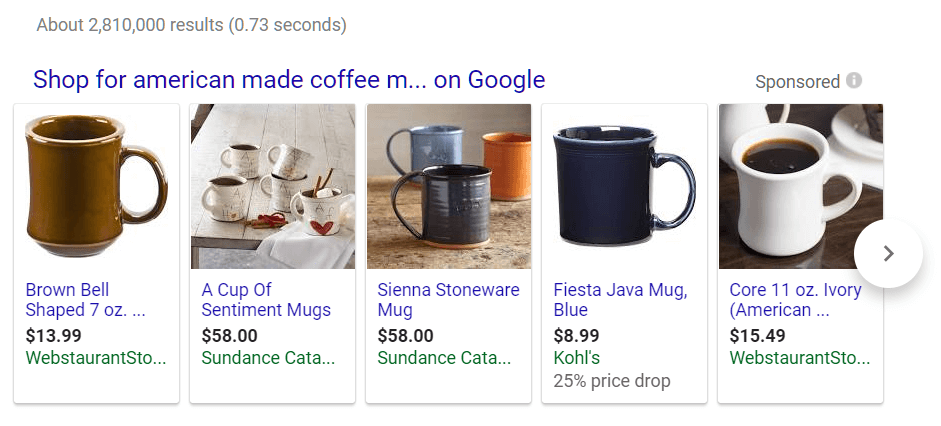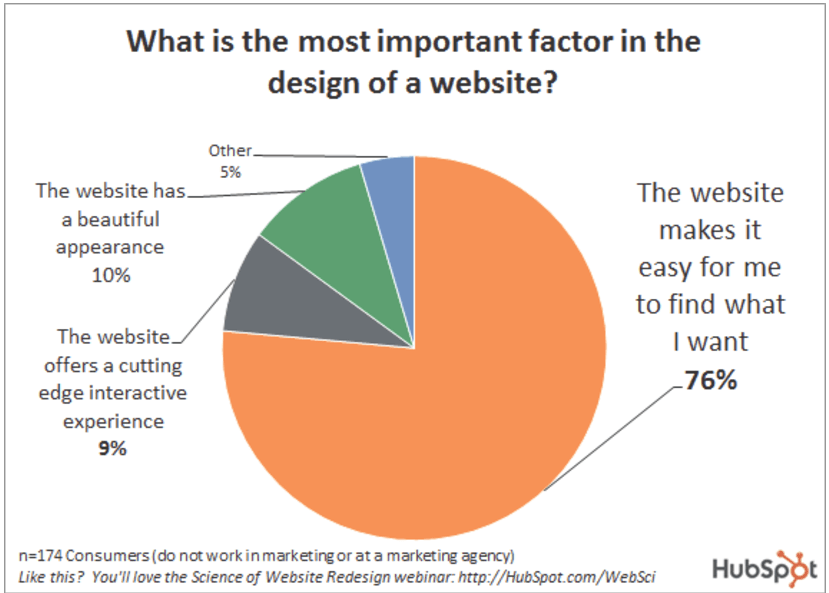
What is the Value of Usability to Conversions?
Does making a website more user friendly really provide any value? The answer is yes, and we show you why.
Imagine yourself undergoing the following scenario, then ask yourself, “Is this an example of “usability” or is it not?
Are you ready?
You want to purchase a certain item – let’s say a coffee mug made in the USA. It’s your desire to join the “Buy American” movement. You want to impress the gang at the office. No more “Made in China” for you.
Checking the search engine results for “American made coffee mug,” you see something right at the top (below the ads) that catches your attention. “Americans Working.” You like that idea.

Here’s that screen clip from a Google search:
So you click… and end up in a directory.
Drats! You were hoping to be presented with a page showing a wide selection of coffee mugs made right here in the USA.
Since you’re there, though, why not click through to one of the listings – the one that says “Coffee Cups” in large, bold font.
Surely, this page will strike gold. You’ll soon be selecting your new USA-stamped mug and setting it on your desk (after receiving quick and free shipment, of course).
Uh-oh. Foiled again.
The choices that link leads to are an engraved glass mug, an engraved glass mini-mug, and a Michigan Love mug. Not only do those mugs miss by a mile what you had in mind, there’s zero description to tell you about size, construction, quality, or to assure you they really are made in the USA (as opposed to sold in the USA).
What now? You thought this would be easy.
Now, think about the question: Was that fruitless journey an example of usability?
Was it “good usability” or “poor usability”?
Meanwhile, let’s take a look at the definition of “usability” and why it’s important.
Why? Because usability can make or break an ecommerce website.
Usability can make or break an ecommerce website. Share on XThe Definition of Usability
Jakob Nielsen is arguably a usability sage. He’s been studying the topic since it first became a topic.
Nielsen’s clients include Adobe, Dell, Google, Motorola, Sony… just about every major brand you can think of really, and his “Usability 101: Introduction to Usability” is a constantly quoted resource in the usability field.
So let’s start there.
Here’s how Jakob Nielsen defines usability:
- Learnability: How easy is it for users to accomplish basic tasks the first time they encounter the design?
- Efficiency: Once users have learned the design, how quickly can they perform tasks?
- Memorability: When users return to the design after a period of not using it, how easily can they reestablish proficiency?
- Errors: How many errors do users make, how severe are these errors, and how easily can they recover from the errors?
- Satisfaction: How pleasant is it to use the design?
Your quest for an American-made coffee mug passed four out of five of those tests. At each step along the way, there was little to learn, it didn’t take you long to figure out what to click, you could do it all over again next week or next year (though we both doubt you’ll do that), and there were few chances for error.
But your satisfaction level was zilch. Usability is so crucial that a failure in one area can destroy the overall experience.
Your disappointment wasn’t just because you discovered hardly anyone actually manufactures products in the USA anymore – there was more to it than that.
You wanted more information. You wanted someone to show that they care as much about their products as you do about finding them.
You wanted to be sold.
Usability Converts
Here’s a truth you can take to the bank: Usability converts.
Google is the giant it is today because it distinguished itself from other search engines. And it did that by returning the most accurate results.
That was before dollar signs replace “Don’t be evil” and online advertising was still in its infancy.
Well, at least that’s the way it feels sometimes.
Take your “American made coffee mug” search.
Here are Google’s top five offerings:

You’re confident that not all of those 2.8 million pages found are paying Google for ads, but wouldn’t you think every return would actually be American made?
The Sundance mugs in the middle are, but the other three… not so much.
Not only does usability sell, but the higher the usability, the better the sales.
When asked what they think is the most important aspect of a website, 76 percent of respondents say they want a website that “makes it easy for me to find what I want.”
Only ten percent place “a beautiful appearance” at the top of the list (see the graphic below).

There’s no magic here. The easier it is for visitors to find what they’re looking for, check out, and go on to the next item on their list… the more sales you’re going to make. You don’t need statistics for that. Look to your own experience.
For those who do need stats, though, here are a few:
- A study by the User Experience and Decision Making Research Laboratory at Worcester Polytechnic Institute found that optimizing mobile pages for user experience returned a 30 percent increase in sales and a 50 percent decrease in bounce rate.
- The Customer Experience Index (2013) by Forrester Research compared ecommerce user experience over a six-year period. That study found the top ten usability leaders outperformed the S&P control group by 43 percent. The bottom ten underperformed by 34 percent. Doing the math, that’s a 77 percent gap.
- The outdoor lifestyle brand, Snow Peak, was putting a big chunk of the budget into getting visitors to their website. Their low conversion rate, though, couldn’t justify the outlay. The Good evaluated the site by developing a Stuck Score™, then used those results to improve usability. Consequently, Snow Peak’s conversion rate increased by 108 percent and pushed a 30 percent increase in average order value.
Here’s another reason why usability is important to every ecommerce website: Paying attention to usability during development helps get launches or changes up and running quicker. The higher the usability, the more effective the site.
Developers know the practical value of conducting ongoing usability studies as work on the site progresses. That allows the team to catch flaws quicker, make changes easier, and get out a functional product sooner.
Great projects not only need a strong “Why” factor and a feasible “How” factor, there’s one huge piece of the puzzle that sometimes gets overlooked until problems start sinking the ship.
The user experience/usability side of the equation is “What.”
- What are we trying to accomplish in the first place?
- What will the benefits be to the user?
- What should the finished product look like?
- What works and what doesn’t work?
- What do we want the user to do, think, or feel?
Looking for more statistics?
Try these:
- During the What phase of development, your cost to resolve problems is at its lowest. Solving a problem after launch is 100 times more expensive.
- Usability is the common factor in the top four reasons software projects go over budget.
- Usability testing during development gets products to market faster, at less expenses, and at a higher quality.
Here’s an Excellent Source of Usability Information
Web usability is something we think about a lot, here at The Good. It’s a topic central to the conversion optimization work we perform for our clients. There’s no way to solve conversion optimization problems without considering user experience.
Usability is an integral component.
In fact, we published an free in-depth resource on the benefits of usability and data called The ROI of Data-Backed Website Design and User Experience Testing.
In it, we highlight the tangible bottom line benefits of using data and testing to help improve your website’s usability.
Download a copy to start understanding the incredible potential that increased web usability could bring to your business.
Let us know what you think in the comments!

About the Author
Jon MacDonald
Jon MacDonald is founder and President of The Good, a digital experience optimization firm that has achieved results for some of the largest companies including Adobe, Nike, Xerox, Verizon, Intel and more. Jon regularly contributes to publications like Entrepreneur and Inc.

